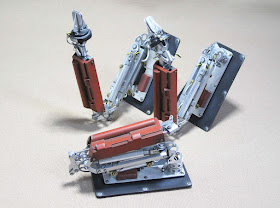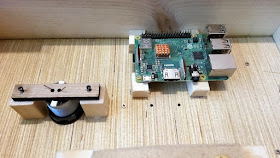I do all my photo editing on the PC. But (by default), the Instagram web page doesn't let me post from the browser on the PC. However, there is a very simple work-around for this which I want to share here.
All Blog Posts by Category
Thursday, November 4, 2021
How to post to Instagram from your PC in the browser
Monday, November 1, 2021
How to play Flash swf files in Ubuntu Linux (works also for Windows and Mac)
A long time ago, I found a wonderful animation that was available as a flash .swf file. In those days, I was able to play this on my Linux computer in Firefox.
These days, however, Flash is no longer supported and my old instructions do not work anymore. It took me a while to find the solution. But it's really simple and I want to share it here.
A player for Adobe Flash content is still available at the Adobe web page. I just seems that they do not really promote it, but you find it here: https://www.adobe.com/support/flashplayer/debug_downloads.html
What you need is the "Flash Player Projector content debugger". This is available or Windows, Mac, and, ... ,yes: Linux. It comes as a .tar.gz file. Now, you either already know what to do, or, if not, just follow these simple step-by-step instructions:
- Open a terminal, and create a new directory, maybe "flash", and enter it
mkdir flash
cd flash - Copy your .swf file(s) into this directory (using command line or file browser) .
- Also copy the file that you downloaded from Adobe "flash_player_sa_linux_debug.x86_64.tar.gz" into this directory.
- Unpack the file
tar -xf flash_player_sa_linux_debug.x86_64.tar.gz
Or, from the file browser: right-click on the file, and "extract here".
Now you have the unpacked file "flashplayerdebugger" - Play your .swf file
./flashplayerdebugger my-flash-file.swf
(of course, replace "my-flash-file.swf" with the name if your .swf file).
The "./" is needed! Otherwise the system will not find the executable.
(yes, it's singing cats!)
Monday, October 18, 2021
How to create a Windows bootable USB drive on Linux
Cannot find C:\sources\install.wim
- What went wrong?
The file "install.wim" has a size of 4.6 GB, which is too large for a USB drive formatted in FAT32. - The solution:
Format your USB drive in exFAT.
Step-by-Step Guide
Formatting a USB drive to exFAT
These simple steps are all done on the command line.- Download the Windows .iso file from Microsoft.
- The following procedure require the"exfat-utils" which were not installed by default on my Kubuntu 21.04. You can install these from your software center (Discover, Muon, or whatever you prefer) or from the command line: sudo apt install exfat-utils
- Insert the USB stick (at least 8GB) in your Linux system and mount it (e.g. from the file manager).
- Find the device ID of the USB stick. There are many ways how to do this. I use
df -m
from the command line. It displays all available filesystems, their status and their IDs If you compare the output of this command before and after mounting the USB stick, you can identify the USB stick. For me it is:
/dev/sdb1 14798 5574 9224 38% /media/username/9B62-A3DF
So, the device ID is "/dev/sdb1". Sometimes my USB drives are also mounted as "/dev/sdc1". Remember this device ID! - Unmount the USB drive, either from the filemanager (right click, "safely remove") or from the command line (replace "/dev/sdb1" with your device ID, if different):
umount /dev/sdb1 - Format the USB drive to ExFat (again, replace "/dev/sdb1" with your device ID, if different):
sudo mkfs.exfat /dev/sdb1 - Mount the freshly formatted USB drive (you may have to remove and re-insert it).
Install the Windows .iso File
- I prefer using the File Manager, which does not require to install any additional software. For this, open the Folder in which you stored the Windows .iso file that you got from Microsoft. Right-click on the .iso file and select "Mount ISO". A new entry will show up on the left bar in the File Manager (with a weird name). Click on this, and the File Manager will display the content of the .iso file
 In a second instance of the File Manager, open the (empty, freshly formatted) USB drive. Then, using the mouse, select all the files from the .iso and copy them over to the USB drive. This will take a few minutes (after all these are >5 GB).
In a second instance of the File Manager, open the (empty, freshly formatted) USB drive. Then, using the mouse, select all the files from the .iso and copy them over to the USB drive. This will take a few minutes (after all these are >5 GB).
The following is not necessary, but as a cross check you may want to enter the folder "sources", hover the mouse over the file "install.wim" and confirm that its size is 4.6 GB. - Alternatively, you can get "unetbootin" from here: https://unetbootin.github.io/. Download the version for your OS (for me it was "Linux", "64 bit binary"). In my case, the downloaded file has the name "unetbootin-linux64-702.bin" (which may differ for future releases) and it's stored in the directory "~/Download". After mounting your USB drive, you run:
sudo ~/Downloads/unetbootin-linux64-702.bin
During startup, I get some error messages mentioning "Arch Linux" and "mtools" which I just ignore (just press "ok"). This opens the following window.Here, you select (1.) "DiskImage", (2.) select the Windows .iso file, select (3.) "USB Drive" and (4.) your drive ID ("/dev/sdb1" or correspondingly), and (5.) press "OK".
Please let me know in the comments, if it helped you or if you ran into any problems.
Tuesday, October 12, 2021
Building the Dewey Drone from "Silent Running" (1972) - Part VI: Arm and Electronics
Previous posts in this series:
- Building the Dewey Drone from "Silent Running" (1972) - Part I: Getting Started
- Building the Dewey Drone from "Silent Running" (1972) - Part II: Main Body and Sides
- Building the Dewey Drone from "Silent Running" (1972) - Part III: Adding Details
- Building the Dewey Drone from "Silent Running" (1972) - Part IV: Legs and Feet and Toes
- Building the Dewey Drone from"Silent Running" (1972) - Part V: Painting and Assembly
Dewey's Arm
Here are the pieces, cut with a laser cutter (plus two wooden rods of 3/8" diameter), partially assembled,
Dewey's Watering Can
Dewey in my Yard
Friday, September 3, 2021
A Replica of the HAL 9000 Punch Card
In "2001: A Space Odyssey" (at about 1h10), HAL 9000 just predicted the 100% failure of the AE-35 unit within the next 72 hours. To discuss this with Frank Poole, Dave Bowman asks HAL to provide a hard copy - and we see the punch card emerging on the left side.
- Master Replicas has produced replicas of these punch cards which are sold at toynk.com and at amazon.com for $34 (for a set of five cards). They say these are officially licensed from Warner Bros.
- At yourprops.com, there are two users who present identical punch cards, which differ somehow from the Master Replica version (here and here).
I decided to base my version on the Master Replica version.
With the open-source desktop publishing software Scribus, I proceed as follows:
- The card itself is supposed to be 3" x 5", so I make a file of 4" x 6" (which can be printed e.g. at Walgreens on 4" x 6" photo paper).
- The HAL 9000 logo is made using the font "GrotesqueNo9T" which is manually outlined in Scribus with 2.5% linewidth, at 31pt.
- For the computer/typewriter font, I am using Artisan12 at 7pt.
- I do not have a paper punch for the rectangular holes, so I print those as grey fields.
And here is my result:
Tuesday, August 24, 2021
HAL 9000 Replicas - beyond the face plate - part II
In this entry, I am building unit #3, which is ...
The HAL console in the Pod Bay Room
The original has a huge sticker, with a white boundary and a blue vertical column. From the BluRay capture, it is impossible to see what it says, so I make something up.






























































